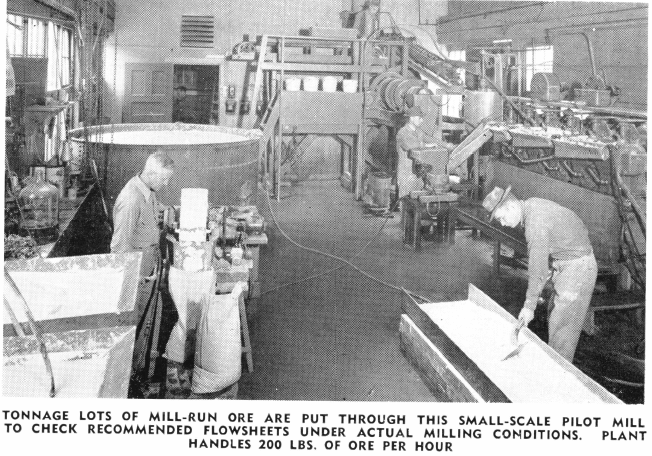Metallurgical Pilot Plant

The Metallurgical pilot concentration plant is completely equipped with gravity and flotation units sufficient to provide for practically any flowsheet employing these methods of concentration. All equipment for the pilot concentration plant is set for continuous operation. Due to movable launders, pumps, and flow pipes, extreme flexibility is available. Crushing: Ore is prepared in the crushing, […]
Citrate Process Analytical Chemistry
One goal of the U.S. Bureau of Mines metallurgy research program is to reduce the objectionable impact of mineral-processing operations upon the environment to the lowest possible level consistent with a viable minerals economy. The citrate process for flue gas desulfurization of (FGD) is a product of continuing Bureau research in pursuit of this goal, […]
Dust Scrubbers
Currently, most coal mines rely primarily on two methods for controlling dust. The first utilizes large volumes of outside air to ventilate and dilute the dust (and methane gas) to acceptable concentrations. The second method involves water used in various ways, such as water spray systems. Unfortunately, both techniques have limitations. For example, increasing the […]
Wet VS Dry Particle Size Analysis
The analysis of particle size distributions has become increasingly important in industrial processes. Particle size is recognized to be fundamental to the control of operations as diverse as grinding, crystallization, emulsification, agglomeration, and more. Particle size determination has traditionally been relegated to the laboratory, and is performed by slow, labor-intensive methods such as sieving, sedimentation […]
Laboratory Scrubber
The Bureau of Mines has funded an extensive research program to develop improved scrubbers for coal mine applications. This work shows that scrubbers can offer a highly effective technique for dust control during many mining operations. In the most recent applications, these scrubbers are usually mounted on or in the mining machine, and minimum scrubber […]
Laboratory Gas Generators
There are many forms of these, and to describe them would of itself fill a volume. A simple generator for hydrogen sulphide, carbon dioxide or hydrogen is shown in Fig. 106. The acid is held in the bottle, which is provided with a tubulature. The iron sulphide, etc., is in the calcium chloride jar, B. […]
Laboratory U-tubes
Gases, Drying and Absorbing.—For this purpose U-tubes, potash bulbs, calcium chloride tubes and calcium chloride jars are used. U-tubes, Fig. 103, are made in a number of forms and are suited to drying gases by the use of calcium chloride, anhydrous copper sulphate, sulphuric acid, etc. Figs, a 103 and b 103 are good forms […]
Laboratory Flasks
Laboratory Flasks may be obtained in some fifteen or twenty different forms, of which the Erlenmeyer and the globe are most used in analytical laboratories. The Erlenmeyer is shown in a, Fig. 102. It is an excellent flask in which to filter by suction (see Chapter III.), for titrations, where precipitates are to be formed […]
Laboratory Carboys
These are used in laboratories for the storage of solutions, and acids, ammonia, etc., are received in them. The problem with them is usually how to get the contents out of them. One of the easiest ways is to place the carboy in a Stevenson’s tilter. This consists of a pair of rockers so fixed […]
Laboratory Aspirators
The simplest form of aspirator consists of two large bottles, a, Fig. 98, both of which are tightly stoppered with rubber stoppers. Through each of these stoppers pass two tubes, one reaching from a few inches outside to within a fraction of an inch of the bottom of the bottle, the other reaching to just […]
